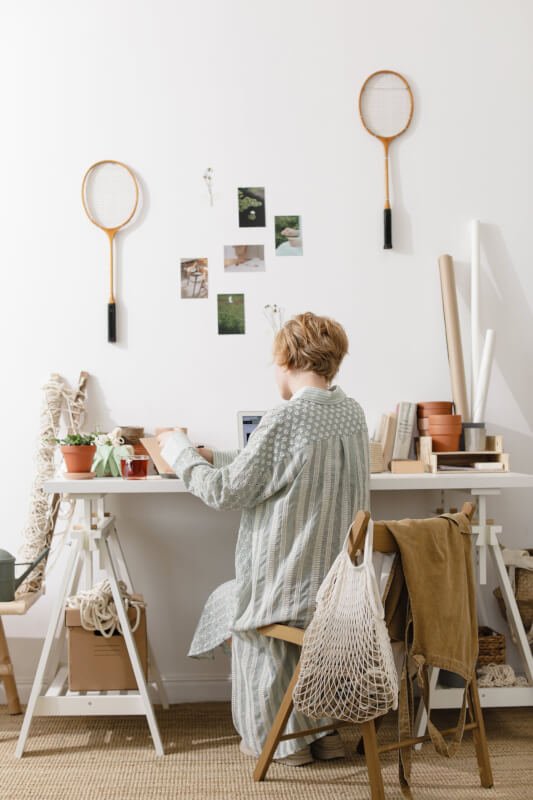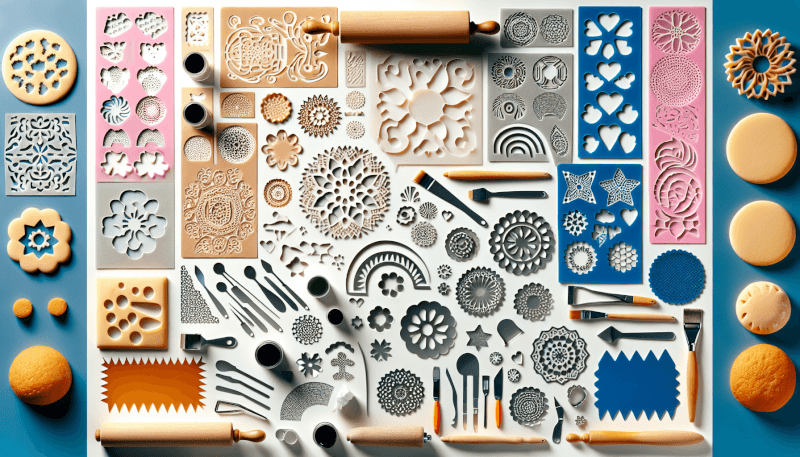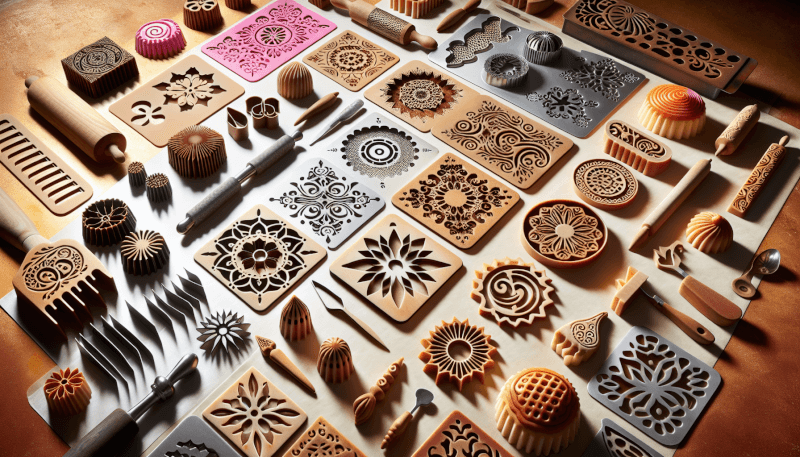Are you looking to add a touch of creativity to your baking? If so, then you’re in the right place! In this article, we will be comparing different types of baking stencils that can help you achieve stunning and eye-catching designs on your cakes, cookies, and other baked goods. From traditional stencils to magnetic ones, we will explore the pros and cons of each type, allowing you to make an informed decision and take your baking skills to the next level. So, let’s dive into the world of baking stencils and discover the endless possibilities they offer for beautiful and artistic decoration.
1. Plastic Stencils
1.1 Advantages of Plastic Stencils
Plastic stencils are a popular choice among bakers and decorators for their various advantages. Firstly, plastic stencils are durable and long-lasting. They are made from tough materials that can withstand repeated use and are less likely to break or warp compared to other stencil materials. This durability ensures that plastic stencils can be used for multiple projects without compromising their quality.
Secondly, plastic stencils are lightweight, making them easy to handle and maneuver during the decorating process. Whether you’re a professional cake artist or a home baker, the lightweight nature of plastic stencils allows for precise designs and intricate details to be achieved effortlessly.
Another advantage of plastic stencils is that they are generally more affordable compared to other stencil materials. This affordability makes them accessible to a wider range of bakers, allowing for creativity and experimentation without breaking the bank.
1.2 Disadvantages of Plastic Stencils
While plastic stencils have many advantages, it’s important to also consider some of their disadvantages. One of the main drawbacks of plastic stencils is their limited flexibility. Compared to other materials like silicone or metal, plastic stencils are less pliable and may struggle to conform to curved or irregular surfaces. This limitation can be a hindrance when trying to achieve certain complex designs or when working on uneven cake surfaces.
Another disadvantage of plastic stencils is their potential for static electricity build-up. Due to the material’s composition, plastic stencils can attract dust particles or other debris while in use. This can affect the quality of the design and require more frequent cleaning or maintenance.
1.3 Best Uses for Plastic Stencils
Plastic stencils are highly versatile and can be used for a wide range of baking and decorating projects. They are particularly well-suited for flat surfaces such as cakes, cookies, or fondant. Plastic stencils are ideal for creating patterns, motifs, or text designs that require precision and clean lines.
For home bakers or those new to stencil decoration, plastic stencils are a great option to start with due to their affordability and ease of use. They are also a popular choice for bulk or large-scale production, as they can be easily cleaned and reused multiple times.
2. Metal Stencils
2.1 Advantages of Metal Stencils
Metal stencils offer a different set of advantages compared to plastic stencils. Firstly, metal stencils are incredibly durable. Made from materials such as stainless steel or aluminum, metal stencils can withstand heavy use and are resistant to damage or wear over time. This durability ensures that metal stencils can be relied upon for consistent and high-quality results.
Secondly, metal stencils are highly flexible and can easily conform to various curved or irregular surfaces. This makes them particularly suitable for decorating cakes with unique shapes or intricate designs. Metal stencils provide the freedom to create elaborate patterns and textures, enabling bakers to showcase their creativity.
Another advantage of metal stencils is their heat conductivity. When used for baking, metal stencils can transfer heat more efficiently, resulting in more even and consistent baking. This allows for precise detailing even on baked goods, ensuring a professional finish.
2.2 Disadvantages of Metal Stencils
While metal stencils have their benefits, they also come with a few drawbacks. One of the main disadvantages of metal stencils is their weight. Metal stencils are generally heavier compared to other materials, which can make them more challenging to handle and manipulate. This added weight can also increase the risk of accidentally smudging or smearing the design while working.
Another potential drawback is the cost of metal stencils. Due to their durable and high-quality nature, metal stencils are often priced higher than plastic or paper stencils. This can be a deterrent for budget-conscious bakers or those who don’t require stencils for frequent use.
2.3 Best Uses for Metal Stencils
Metal stencils excel in a variety of baking and decorating applications. They are exceptionally well-suited for cake decorating, especially when intricate designs or fine details are required. The flexibility of metal stencils allows them to mold to the contours of various cake shapes and sizes, creating seamless and visually stunning decorations.
Furthermore, metal stencils are ideal for achieving embossed or engraved effects on fondant or marzipan. Their heat conductivity makes them perfect for working with hot sugar or isomalt, enabling bakers to create delicate edible decorations with precision.

3. Silicone Stencils
3.1 Advantages of Silicone Stencils
Silicone stencils offer unique advantages that make them a popular choice among bakers and decorators. Firstly, silicone stencils are highly flexible and can easily conform to different shapes and contours. This flexibility allows for seamless application on rounded surfaces such as cakes or cupcakes, making them particularly useful for three-dimensional designs.
Secondly, silicone stencils are non-stick, which means they release easily from the decorated surface without causing any damage or smudging. This makes them ideal for delicate designs or intricate patterns that require intricate placement or layering.
Additionally, silicone stencils are dishwasher safe and easy to clean. The non-stick property of silicone ensures that any residual icing or color comes off effortlessly, saving time and effort during the cleaning process.
3.2 Disadvantages of Silicone Stencils
While silicone stencils have several advantages, they also have a few disadvantages worth considering. One of the main drawbacks of silicone stencils is their flexibility. While this characteristic allows them to conform to curved or irregular surfaces, it can also make them more difficult to handle. The flexibility of silicone stencils can result in slight shifting or movement during the decorating process, potentially affecting the precision of the design.
Another potential disadvantage is the cost of silicone stencils. Compared to other materials like plastic or paper, silicone stencils tend to be relatively more expensive. This higher cost may deter some bakers, especially those who only require stencils for occasional use or have budget constraints.
3.3 Best Uses for Silicone Stencils
Silicone stencils are well-suited for a range of baking and decorating projects. Due to their flexibility, they are particularly useful for cakes or cupcakes with complex shapes, such as spheres, domes, or tiered designs. Silicone stencils enable bakers to effortlessly achieve seamless patterns and designs on these intricate surfaces.
Furthermore, silicone stencils are popular for airbrushing techniques. The flexibility of silicone allows for easy blending of colors and gradients, resulting in stunning, multi-dimensional effects on cakes or cookies. The non-stick property of silicone also ensures that the stencils can be easily removed without damaging the delicate airbrushed design.
4. Paper Stencils
4.1 Advantages of Paper Stencils
Paper stencils offer their own unique advantages that appeal to certain bakers and decorators. Firstly, paper stencils are incredibly affordable and readily available. They can be easily made at home or purchased from craft stores without breaking the budget. This accessibility makes paper stencils a popular choice for beginners or those who require stencils for one-time use or occasional projects.
Secondly, paper stencils are lightweight and easy to handle. Their thin and pliable nature allows for precise application and clean lines. Bakers can achieve intricate details with ease, as paper stencils can conform to various surfaces, including curved or irregular ones.
Another advantage of paper stencils is their disposable nature. Once used, paper stencils can be discarded, eliminating the need for cleaning or storage. This convenience makes them a preferred option for quick and temporary designs.
4.2 Disadvantages of Paper Stencils
While paper stencils have their advantages, they also come with a few disadvantages. The main drawback of paper stencils is their limited durability. Paper stencils are prone to tearing or warping, especially when exposed to moisture or excessive handling. This fragility can make it challenging to reuse paper stencils or achieve consistent results across multiple projects.
Additionally, compared to other stencil materials, paper stencils are more susceptible to color bleeding or smudging. The porous nature of paper can allow colors and icing to seep through the stencil design, resulting in blurred or distorted patterns. This can limit the precision and overall quality of the final decoration.
4.3 Best Uses for Paper Stencils
Paper stencils are a versatile option that can be used for various baking and decorating projects. They are particularly suitable for simple designs or when experimenting with new patterns or motifs. Paper stencils are often used in combination with powdered sugar or cocoa powder to create elegant and effortless designs on cakes, pies, or cookies.
Furthermore, paper stencils are popular for making temporary markings or guides during the decorating process. Bakers can use paper stencils to trace or transfer designs onto cakes or cookies, allowing for consistent and accurate placement of decorations, such as piping or hand-painted details.

5. Custom-Made Stencils
5.1 Advantages of Custom-Made Stencils
Custom-made stencils offer the advantage of personalized designs and tailored solutions to specific baking and decorating needs. Firstly, custom-made stencils allow for unique and one-of-a-kind designs. Bakers and decorators can have their own artwork or logos transformed into stencils, enabling them to create signature designs that reflect their individual style or brand.
Secondly, custom-made stencils offer greater control over the size and dimensions of the design. Bakers can customize the stencil to the exact measurements needed for their cakes or cookies, ensuring a perfect fit and seamless application.
Another advantage of custom-made stencils is the ability to choose the stencil material that best suits the project. Whether it’s plastic, metal, or silicone, bakers can select the most appropriate material based on their desired outcome and the surface they will be working on.
5.2 Disadvantages of Custom-Made Stencils
While custom-made stencils offer many benefits, there are a few potential disadvantages to consider. Firstly, the process of creating custom-made stencils can be time-consuming and require additional resources. Bakers may need to work with a graphic designer or stencil manufacturer to bring their design to life, which can involve extra costs and coordination.
Additionally, the cost of custom-made stencils is generally higher compared to pre-made stencils. The customization process, along with the use of specific materials or techniques, can result in a higher price tag. This cost may make custom-made stencils less accessible for bakers on a tight budget or those who only require stencils for occasional use.
5.3 Best Uses for Custom-Made Stencils
Custom-made stencils are ideal for bakers and decorators who want to showcase their unique style or branding. They are particularly useful when creating intricate or highly detailed designs that require precision and accuracy. Custom-made stencils ensure that the desired design is achieved flawlessly, reflecting the individuality and creativity of the baker or decorator.
Furthermore, custom-made stencils allow for consistency across multiple projects or baked goods. For businesses or individuals looking to maintain a cohesive visual identity, custom-made stencils offer the opportunity to replicate specific designs or patterns accurately. This consistency can help establish a recognizable brand or signature style.
6. Reusable Stencils
6.1 Advantages of Reusable Stencils
Reusable stencils offer several advantages that make them a popular choice for bakers and decorators. Firstly, reusable stencils are environmentally friendly and sustainable. By opting for reusable stencils, bakers can reduce waste and minimize their environmental impact. Instead of using disposable stencils for each project, reusable stencils can be cleaned and used multiple times, contributing to a greener approach to baking and decorating.
Secondly, reusable stencils are cost-effective in the long run. While the initial investment may be higher compared to disposable stencils, the ability to reuse them for multiple projects ensures better value for money. This is particularly beneficial for businesses or individuals who regularly use stencils or require consistent designs across various baked goods.
Another advantage of reusable stencils is their durability. Made from sturdy materials like plastic or metal, reusable stencils can withstand frequent use and cleaning without compromising their quality or integrity. This durability ensures that the stencil designs remain crisp and sharp, providing consistently professional results.
6.2 Disadvantages of Reusable Stencils
Despite their advantages, reusable stencils also have a few potential disadvantages. Firstly, cleaning and maintaining reusable stencils can be time-consuming. Depending on the material and complexity of the design, removing residual icing or color from the stencil may require more effort or specialized cleaning techniques. This extra step in the process can add to the overall time spent on decorating projects.
Another potential drawback is the storage space required for reusable stencils. Compared to disposable stencils, which can be easily thrown away after use, reusable stencils need to be properly stored to prevent damage or warping. This can be a challenge, especially for those with limited storage space or multiple stencil designs.
6.3 Best Uses for Reusable Stencils
Reusable stencils are a versatile option that can be used for a wide range of baking and decorating projects. They are particularly well-suited for bakers or decorators who frequently use stencils or require consistent designs across various products. Reusable stencils ensure that the same design can be replicated accurately and efficiently, saving time and effort.
Furthermore, reusable stencils are ideal for business owners or individuals who value sustainability and eco-friendly practices. By opting for reusable stencils, bakers can contribute to reducing waste and promoting a more environmentally conscious approach to baking and decorating. The durability of reusable stencils also ensures that the investment made in them pays off over time, making them a smart choice for long-term use.

7. One-Time Use Stencils
7.1 Advantages of One-Time Use Stencils
One-time use stencils offer unique advantages in certain decorating scenarios. Firstly, one-time use stencils are convenient and require minimal cleaning or maintenance. After using the stencil for a particular project, it can be easily discarded without the need for extensive cleaning or storage. This convenience is especially valuable when time is of the essence or when dealing with intricate designs that may be difficult to clean thoroughly.
Secondly, one-time use stencils come in a wide variety of designs and patterns. They are often available in pre-made sets or collections, offering a range of options for different occasions or themes. This variety allows decorators to experiment with different designs without the need for customization or investing in multiple reusable stencils.
Another advantage of one-time use stencils is their affordability. These stencils are typically less expensive compared to reusable or custom-made stencils. This makes them an attractive option for those on a budget or those who only require stencils for occasional use or specific projects.
7.2 Disadvantages of One-Time Use Stencils
While one-time use stencils have their advantages, they also have a few potential drawbacks to consider. Firstly, the use of disposable stencils contributes to increased waste and environmental impact. Discarding stencils after a single use can become unsustainable, particularly for frequent bakers or decorators. The accumulation of disposable stencils can further strain waste management.
Another potential disadvantage is the limited design options available for one-time use stencils. While there is a wide variety to choose from, decorators may find themselves limited in terms of customization or specific design requirements. The mass-produced nature of one-time use stencils can restrict creativity and limit the ability to achieve unique or personalized designs.
7.3 Best Uses for One-Time Use Stencils
One-time use stencils are particularly suited for specific projects or situations where convenience and affordability are paramount. They are commonly used for events or parties with a specific theme or design requirement. One-time use stencils allow decorators to achieve consistent designs across various baked goods without the need for extensive cleaning or storage.
Furthermore, one-time use stencils are ideal for beginners or those new to stencil decorating. They provide a cost-effective way to experiment with different designs or techniques, allowing for creativity without the commitment of investing in reusable stencils. One-time use stencils also offer a convenient solution for those who may not have the time or resources for cleaning or maintaining reusable stencils.
8. Stencil Sizes
8.1 Small Stencils
Small stencils offer their own set of advantages when it comes to creating intricate or detailed designs. These stencils are typically used for adding subtle accents or delicate patterns to small baked goods like cookies or cupcakes. The compact size of small stencils allows decorators to focus on precise placement and achieving intricate details with ease. Small stencils are particularly popular for adding monograms, initials, or small motifs to individual treats.
8.2 Medium Stencils
Medium stencils provide a versatile option for a range of baking and decorating projects. They are commonly used for medium-sized cakes, allowing decorators to cover larger surface areas with ease. The size of medium stencils provides a good balance between achieving detailed designs and covering a larger space efficiently. These stencils are often used for creating floral patterns, geometric designs, or themed motifs on cakes or other desserts.
8.3 Large Stencils
Large stencils are suitable for grand and statement-making designs. These stencils are commonly used for larger cakes or projects that require bold and eye-catching patterns. The size of large stencils allows for covering significant surface areas effortlessly and can achieve instant impact. Large stencils come in handy when decorating celebration cakes, wedding cakes, or corporate event cakes that demand attention and visual appeal.

9. Stencil Designs
9.1 Traditional Designs
Traditional designs encompass classic patterns and motifs that have stood the test of time. These designs often draw inspiration from vintage or historical elements and can range from elegant filigree to timeless damask patterns. Traditional stencil designs are widely used in formal occasions or events where a touch of sophistication and nostalgia is desired. They are commonly seen on wedding cakes, anniversary cakes, or formal event desserts.
9.2 Modern Designs
Modern stencil designs offer a contemporary twist on traditional patterns or introduce entirely new and innovative motifs. These designs are characterized by clean lines, geometric shapes, or minimalist elements. Modern stencil designs are versatile and can be used for a range of occasions, from casual celebrations to modern-themed events. They are particularly popular for birthday cakes, baby shower desserts, or trendy specialty desserts.
9.3 Intricate Designs
Intricate stencil designs are highly detailed and often require advanced skill and precision to achieve. These designs can feature elaborate floral arrangements, lace-like patterns, or intricate mandalas. Intricate stencil designs are commonly used for special occasions or showpiece cakes that demand intricate detailing and visual impact. These designs require patience and attention to detail, resulting in stunning works of edible art.
10. Stencil Versatility
10.1 Floral Stencils
Floral stencils offer a versatile option for a wide range of baking and decorating projects. These stencils feature various types of flowers, from delicate blossoms to bold blooms. Floral stencils can be used to decorate cakes, cupcakes, cookies, or even chocolates, adding a touch of elegance and natural beauty to any dessert. They are popular for weddings, garden-themed events, or any occasion that calls for a feminine and enchanting touch.
10.2 Holiday Stencils
Holiday stencils capture the spirit and theme of specific celebrations or seasonal events. These stencils come in a variety of designs, ranging from Christmas motifs to Halloween symbols or Easter themes. Holiday stencils allow bakers and decorators to effortlessly add a festive touch to their baked goods. Whether it’s a snowflake pattern, a pumpkin design, or a heart stencil for Valentine’s Day, holiday stencils bring joy and seasonal cheer to any dessert.
10.3 Geometric Stencils
Geometric stencils offer a contemporary and modern approach to decorating. These stencils feature clean lines, bold shapes, and intricate patterns inspired by geometric elements. Geometric stencils can be used to create stunning abstract designs or precise geometric patterns on cakes, cookies, or other desserts. They are particularly popular for minimalist or modern-themed events, providing a sleek and visually striking decoration option.
In conclusion, comparing different types of baking stencils highlights the unique advantages and disadvantages of each material, size, design, and purpose. Whether you choose plastic, metal, silicone, paper, custom-made, reusable, or one-time use stencils, there is a wide range of options available to suit every baker and decorator’s needs. By considering the specific requirements of your project, you can select the most appropriate stencil that will enhance your creativity and elevate your baked goods to a whole new level of decorative artistry.



